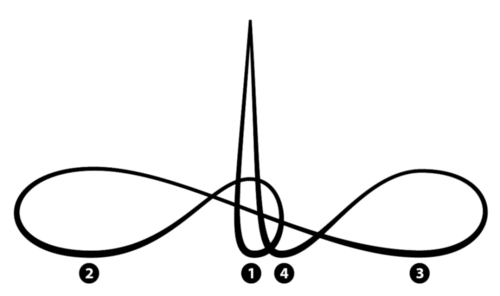 In conducting, it is important to make fluent movements. Making the patterns really legato isn’t easy. Good drawings of the beating patterns may be helpful in the learning process. Much to my surprise, the drawings in existing books on conducting look rather bad. They are more schemes pointing in the right direction than drawings of how the actual movements should look like. Thus, I took the challenge of creating beautiful drawings of the beating patterns.
In conducting, it is important to make fluent movements. Making the patterns really legato isn’t easy. Good drawings of the beating patterns may be helpful in the learning process. Much to my surprise, the drawings in existing books on conducting look rather bad. They are more schemes pointing in the right direction than drawings of how the actual movements should look like. Thus, I took the challenge of creating beautiful drawings of the beating patterns.
In this post we are focusing on the first one, the legato 4-beat pattern. (This is the pattern you use when there are four beats in the bar, like in the 4/4 time.) With the term legato I mean in this case that you are making fluent movements on all four beats.
I have tried to make the figure as objective as possible. The figure is based on the theories explained in the common literature on beating technique (especially the excellent book of Brock McElheran) and on my own experience in teaching conducting.
The figure below is characterized by the following:
– The beating points all lie on the same height. In other words, the beating points lie on a horizontal line. This is the prevailing view of the past decades.
– The 4 lies close to the 1, rather than in between the 3 and 1. This implies that the movement from 4 to 1 is vertical.
– The movement towards the left on 2 is about the same size as the movement to the right on 3. In this way the figure is nicely centred around the 4 and 1.
– The movement going up from 4 to 1 is about the same size as the movements on 2 and 3. In this way the loudness that is indicated on all beats is more or less the same.
In the beating the hand has the highest speed near to the beating points. To reflect this, the lines at the bottom of the figure are bolder than at the top.
The resulting 4-beat patterns is like this:

In the pattern, a couple of small adjustments have been made, in order for the drawing to be comprehensible:
– In the drawing, the beats 1 and 4 are depicted close to one another. In reality you might make these beats on the exact same spot, so the movement of from 4 to 1 is completely vertical.
– The movement after 1 to the right is depicted small, so that is doesn’t collide with the movement after 3. In the actual movement you might make the move from 1 to the right nearly as big as the movement after 3.